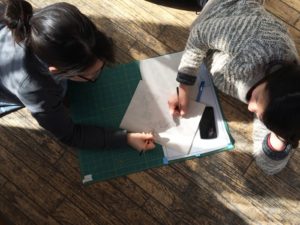What’s an engaging way to get citizens proactive in city development? Get them to sketch a tree house, of course. And that’s what Crazy Dames—made up of artist Jennie Suddick and urban planner Sara Udow—intend to do at Open Space’s upcoming Creative Placemaking Workshops. The workshops are divided into two separate events, the first of which is the Tree House Workshop. This workshop lets people create their dream tree house or fort; Suddick will create paper models of them for her 2018 art exhibition The Tree House Project.
Suddick says that, for her, there is a kernel of personal experience within the idea of this project. She says that she was really intrigued by the desire to have a tree house.

“I grew up in the suburbs, and it was a new development, so all our trees were recently planted, tiny little things that you could never really build a tree house on. My parents didn’t really have time to do something like build a tree house with me, so me and a friend had drawn plans of a tree house we wanted, and then that actually became the experience. I started realizing that this idea of a tree house, which is sort of this idyllic symbol for childhood, is something we still often think of; however, most people don’t actually ever experience or get to make it.”
Considering her work revolves around attachments to buildings and objects, the Tree House Project is a natural fit. But those who have no experience with tree houses don’t need to fret; the workshop is still for them.
“It’s usually as much remembering for people who had them then as [it is for] people who didn’t have them,” says Suddick.
After collecting the sketches, Suddick plans to create blueprints and models for these often elaborate drawings, although she and Udow focus more on the experience than on the finished product.
“Our work experience is process-oriented,” says Udow. “We’re not really that interested in creating one final product for the community in Victoria or the City of Victoria. It’s more about creating a new way of thinking around city building, both placemaking and artmaking.”
Suddick says that each workshop’s informal, low-stakes atmosphere allows people without any credentials to participate, which makes sense, as the planning of a city affects all of its citizens.
“We feel like a playful, explorative approach allows people to feel like they have a place in both artmaking and placemaking,” adds Udow. “I think a lot of people who aren’t artists are afraid of creating something that’s not going to be good, or that it’s not their place. And it’s the same with placemaking. People will think, ‘Oh, [this is for] this professional architect, or this professional planner, and it’s their role to define what the city should need and how our spaces should be built.’ We’re trying to say, no, everyone should be able to have a say in this and can contribute meaningfully; that’s part of the purpose of it.”
As workshop participants collaborate with fellow community members, architects, and city planners, Udow says the experimentation that comes from the workshops’ art-studio-like process helps citizens see spaces in a less finite way.
“Space is never static; it’s always dynamic and changing,” she says, “so instead of just coming up with one solution and that’s it, it’s always about making tweaks and changing the spaces in different ways.”
Tree House Workshop
6:30 pm Tuesday, June 20
Placemaking Workshop
3 pm Thursday, June 22
Free, Open Space
openspace.ca
